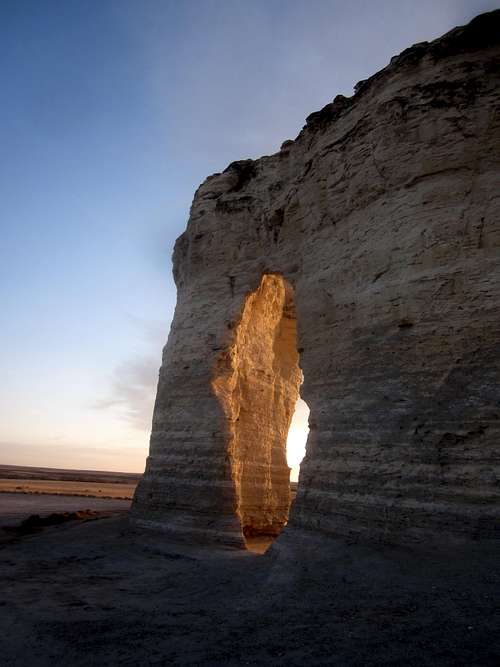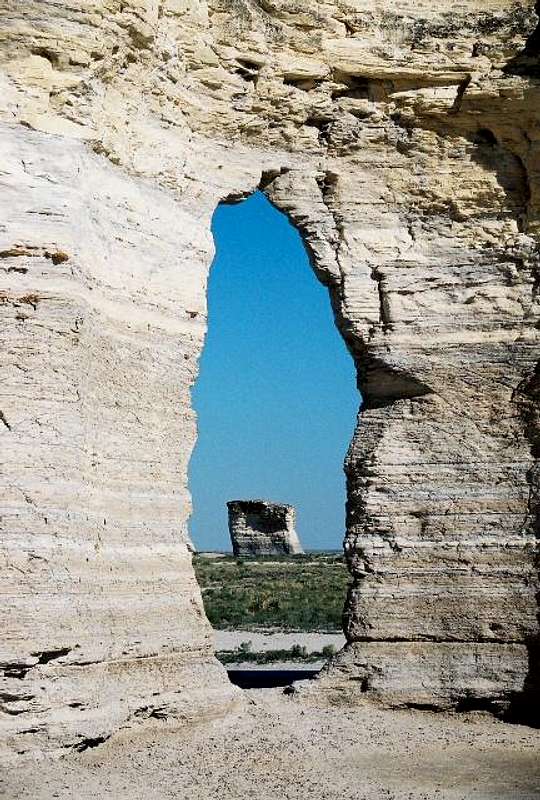-
 20037 Hits
20037 Hits
-
 92.04% Score
92.04% Score
-
 37 Votes
37 Votes
|
|
Area/Range |
|---|---|
|
|
38.79057°N / 100.76237°W |
|
|
Hiking, Scrambling |
|
|
Spring, Summer, Fall, Winter |
|
|
2600 ft / 792 m |
|
|
Monument Rocks
Pep Talk
Kansas needs a little love. There's a little more of outdoor interest there than just much-mocked Mount Sunflower.
In July 2005, I drove through Kansas on my way to Colorado and Utah. As I drove through the uniform scenery along I-70, I studied my road map for possibly interesting places to go see along the way. Castle Rock and Monument Rocks seemed to have potential. When, at a gas station later on, I saw a postcard featuring the Monument Rocks and estimated I'd be close to them in the late afternoon, I made up my mind to go there. It ended up being a nice destination that didn't cost too much time yet showed me a bit of Kansas I'd never have expected to see otherwise.
So give the place a look if you're driving through the state. Kansans know about it, but few others do, and you might be pleasantly surprised to find that Kansas beyond the interstate is a beautiful place.
Overview
Rising like a ruined city from the flat prairies of Western Kansas, the Monument Rocks are a collection of chalk buttes and arches that occupy about 10 acres a short distance south of the town of Oakley. The towers get up to about 70 feet high, but it would be a terrible idea to climb them. First, they are not solid and stable enough for it, and second, climbing on them would easily damage them. There are, however, opportunities for hiking and scrambling, even though dirt roads wind among and around most of the formations.
The region of Kansas that includes the Monument Rocks, Castle Rock, and numerous sandstone bluffs is today known as the "Badlands of Kansas," but 80 million years ago (during the days of the dinosaurs) it was the bottom of an ancient sea. The calcium shells of dead microscopic organisms called foraminera sank to the ocean floor and created an ooze that eventually swallowed the remains of larger animals and was covered by more sediments. Finally, this ooze was transformed by pressure into chalk. Later, the Smoky Hill River went to work, sculpting the chalk layers into the eroded buttes and pinnacles on display today.
The Badlands of Kansas are, not surprisingly considering the geological history, a bonanza of fossils. Local museums and tourist traps display many excellent specimens of dinosaurs and ancient fish. Supposedly, it is easy to find fossilized teeth from ancient sharks turned up in the clays and the chalk after rains. Finding a shark's tooth in a semi-arid, landlocked environment must seem surreal.
As is the case with many other arid places in the world, the Monument Rocks appear barren at first. But the formations and the larger region are home to numerous animals large and small, including rattlesnakes, coyotes, and golden eagles. Among the rocks themselves, Amercan kestrels, which are the smallest of the falcons, nest in holes in the rocks. Pronghorns graze and bound through the nearby shortgrass prairie.
The Monument Rocks were the first area dedicated as a National Natural Landmark. This confers no legally protected status, though, and many such sites are on private property and subject to the whims of the landowners. The National Park Service administers the program and works with landowners to conserve areas of special interest.
The Monument Rocks are also known as the Chalk Pyramids.
Getting There from I-70
Exit I-70 at Exit 70 or 76 and drive to Oakley. Follow U.S. 83 south for almost 20 miles. 2.5 miles north of the Smoky Hill River (so if you cross it going south, you've gone too far), look for a sign directing travelers to the Monument Rocks. Turn east onto a dirt road and follow it for 4 miles. Turn south at what should be a marked junction and follow that dirt road 2 more miles to the Monument Rocks.
The dirt roads are easily passable for regular vehicles when dry. When wet, they may be impassable even to vehicles with real four-wheel drive.
Camping and Red Tape
No developed camping, but there are no signs prohibiting camping.
No restroom facilities.
The site is on private land, but it is open to the public and there are no fees. Please do not litter or drive off-road, and please obey any signs posted by the landowner. Watch out for livestock.







McCannster - Feb 4, 2013 9:44 pm - Voted 10/10
CampingThough these are most likely on private property, I think camping here is generally accepted. There aren't any signs or people to tell you otherwise.